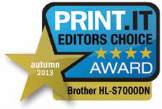Basic HTML Version




22
PRINT.IT
01732 759725
Business Inkjets
Well-known for its consumer and small business
inkjet printers, Brother’s latest model takes it
– and its customers – into uncharted territory.
With print speeds of 100
pages per minute, the HL-
S7000DN inkjet printer is
two and a half times faster
than Brother’s quickest
laser printer and five times
faster than its speediest
inkjet device. This makes it
something of an anomaly in
Brother’s existing product
range, which primarily
addresses the office/mobile
printing needs of small and
medium-sized businesses.
The Brother HL-S7000DN
is a different beast altogether.
Although it could be used as a
workgroup printer in an open
plan office (as shown in the
photo), it is most likely to be
used as a centralised device
for ‘quick burst printing’ in
enterprise print and mail rooms,
as well as copy shops and other
print-for-pay environments.
Few workgroups need 100
pages per minute output. Nor
would many office workers
tolerate the noise generated by
high speed duplex (two-sided)
printing, which, in the case of
the HL-S7000DN, mainly comes
from the movement of paper in
and out of the printer.
To do this, the printer has
two motors – one to pull paper
in and one to push paper out:
it does this with such force
that Brother has had to add
a back-stop to the output tray
(see photo), which doubles as a
status monitor, changing colour
depending on the printer’s
readiness.
Even in quiet mode, which
lowers noise levels by reducing
the print speed to 70ppm, the
Brother HL-S7000DN is a more
productive and noisy machine
than most office workers would
want or need to have close by.
Big advantages
Where it really comes into its
own is when you need to print
a large batch of invoices or
thousands of customer letters
or, in the case of commercial
print providers, turn around a
customer order at very short
notice.
For such applications, the
inkjet HL-S7000DN has four key
advantages over laser devices
with comparable print speeds:
n
It has a low total cost of
ownership thanks to a
suggested retail price of
£2,999 and a high capacity,
30,000-page cartridge
delivering a cost per page of
0.5p. Laser devices with the
same print speed are large
departmental or production
machines costing upwards of
£10,000 to £20,000;
n
It has low power consumption,
with a 60% lower TEC rating
than a laser printer;
n
It is many times smaller than
equivalent laser devices and
ink-based digital duplicators,
partly due to an integral
output tray and partly due to
the lack of finishing options;
and
n
Printed pages are output at
room temperature, unlike
pages printed on laser devices
that can become hot and curl.
This last point is important
as the types of document the
printer is likely to be used
for will often be printed and
automatically folded and
inserted into envelopes prior
to franking. According to
Brother product and solutions
manager Andy Johnson, laser-
printed pages that curl due to
overheating can cause jams in
folder-inserters and franking
machines. “With cold process
inkjet technology you don’t have
any of these issues,” he said.
Primed for performance
But what about the weaknesses
of inkjet printing? How has
Brother tackled problems
such as slow drying inks, ink
bleeding into the page, fading
and blurring? And how has it
been able to deliver consistent,
laser quality output on standard
printer paper at such high
speeds?
The secret is a print
technology that Brother has
been developing for more than
a decade in conjunction with
Kyocera, which uses the same
technology in its industrial
printers.
This has three parts: a fixed
linehead with 5,198 nozzles
spanning the width of the page;
variable size droplets of archive-
proof, ISO 117098-accredited
quick-drying ink; and, from a
separate chamber in the same
cartridge, a special primer that
keeps ink on the surface of
the paper and prevents it from
soaking into the page. The
primer is applied first from a
separate printhead, followed by
the ink.
Other useful features of the
HL-S7000DN include paper
capacities of up to 2,100 sheets
input and 1,100 sheets output;
a powerful 800MHz processor;
2GB of internal storage; Gigabit
Ethernet and Wireless 802.11n
network interfaces; and an open
interface that allows developers
to build customised print
applications.
Conclusion
The Brother HL-S7000DN is
an interesting addition to the
expanding range of business
inkjet devices. It looks like
an office printer but is more
powerful than most workgroups
require and, at £2,999, a lot
more expensive than a typical
laser printer. It has low running
costs, but you would have to
be printing thousands and
thousands of pages to build a
convincing TCO argument. For
this reason, it is most likely to
find a place as a centralised
device in enterprise and public
sector print rooms, where it
offers an alternative/back-up
to laser devices costing 5 or
10 times as much. Its very
high print speeds might also
suit copy shops and other print
providers under pressure to
complete customer jobs in as
little time as possible.
www.brother.co.uk
A step into the unknown

